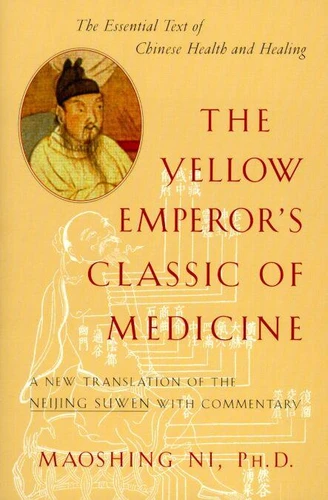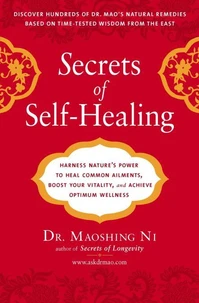The Yellow Emperor's Classic of Medicine. A New Translation of the Neijing Suwen with Commentary
Par :Formats :
Disponible dans votre compte client Decitre ou Furet du Nord dès validation de votre commande. Le format ePub protégé est :
- Compatible avec une lecture sur My Vivlio (smartphone, tablette, ordinateur)
- Compatible avec une lecture sur liseuses Vivlio
- Pour les liseuses autres que Vivlio, vous devez utiliser le logiciel Adobe Digital Edition. Non compatible avec la lecture sur les liseuses Kindle, Remarkable et Sony
- Non compatible avec un achat hors France métropolitaine
 , qui est-ce ?
, qui est-ce ?Notre partenaire de plateforme de lecture numérique où vous retrouverez l'ensemble de vos ebooks gratuitement
Pour en savoir plus sur nos ebooks, consultez notre aide en ligne ici
- Nombre de pages336
- FormatePub
- ISBN0-8348-2576-7
- EAN9780834825765
- Date de parution10/05/1995
- Protection num.Adobe DRM
- Taille990 Ko
- Infos supplémentairesepub
- ÉditeurShambhala
Résumé
The Neijing is one of the most important classics of Taoism, as well as the highest authority on traditional Chinese medicine. Its authorship is attributed to the great Huang Di, the Yellow Emperor, who reigned during the third millennium BCE. This new translation consists of the eighty-one chapters of the section of the Neijing known as the Suwen, or "Questions of Organic and Fundamental Nature." (The other section, called the Lingshu, is a technical book on acupuncture and is not included here.) Written in the form of a discourse between Huang Di and his ministers, The Yellow Emperor's Classic of Medicine contains a wealth of knowledge, including etiology, physiology, diagnosis, therapy, and prevention of disease, as well as in-depth investigation of such diverse subjects as ethics, psychology, and cosmology.
All of these subjects are discussed in a holistic context that says life is not fragmented, as in the model provided by modern science, but rather that all the pieces make up an interconnected whole. By revealing the natural laws of this holistic universe, the book offers much practical advice on how to promote a long, happy, and healthy life. The original text of the Neijing presents broad concepts and is often brief with details.
The translator's elucidations and interpretations, incorporated into the translation, help not only to clarify the meaning of the text but also to make it a highly readable narrative for students-as well as for everyone curious about the underlying principles of Chinese medicine.
All of these subjects are discussed in a holistic context that says life is not fragmented, as in the model provided by modern science, but rather that all the pieces make up an interconnected whole. By revealing the natural laws of this holistic universe, the book offers much practical advice on how to promote a long, happy, and healthy life. The original text of the Neijing presents broad concepts and is often brief with details.
The translator's elucidations and interpretations, incorporated into the translation, help not only to clarify the meaning of the text but also to make it a highly readable narrative for students-as well as for everyone curious about the underlying principles of Chinese medicine.
The Neijing is one of the most important classics of Taoism, as well as the highest authority on traditional Chinese medicine. Its authorship is attributed to the great Huang Di, the Yellow Emperor, who reigned during the third millennium BCE. This new translation consists of the eighty-one chapters of the section of the Neijing known as the Suwen, or "Questions of Organic and Fundamental Nature." (The other section, called the Lingshu, is a technical book on acupuncture and is not included here.) Written in the form of a discourse between Huang Di and his ministers, The Yellow Emperor's Classic of Medicine contains a wealth of knowledge, including etiology, physiology, diagnosis, therapy, and prevention of disease, as well as in-depth investigation of such diverse subjects as ethics, psychology, and cosmology.
All of these subjects are discussed in a holistic context that says life is not fragmented, as in the model provided by modern science, but rather that all the pieces make up an interconnected whole. By revealing the natural laws of this holistic universe, the book offers much practical advice on how to promote a long, happy, and healthy life. The original text of the Neijing presents broad concepts and is often brief with details.
The translator's elucidations and interpretations, incorporated into the translation, help not only to clarify the meaning of the text but also to make it a highly readable narrative for students-as well as for everyone curious about the underlying principles of Chinese medicine.
All of these subjects are discussed in a holistic context that says life is not fragmented, as in the model provided by modern science, but rather that all the pieces make up an interconnected whole. By revealing the natural laws of this holistic universe, the book offers much practical advice on how to promote a long, happy, and healthy life. The original text of the Neijing presents broad concepts and is often brief with details.
The translator's elucidations and interpretations, incorporated into the translation, help not only to clarify the meaning of the text but also to make it a highly readable narrative for students-as well as for everyone curious about the underlying principles of Chinese medicine.





